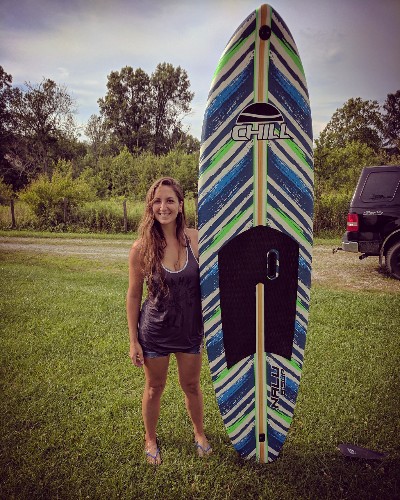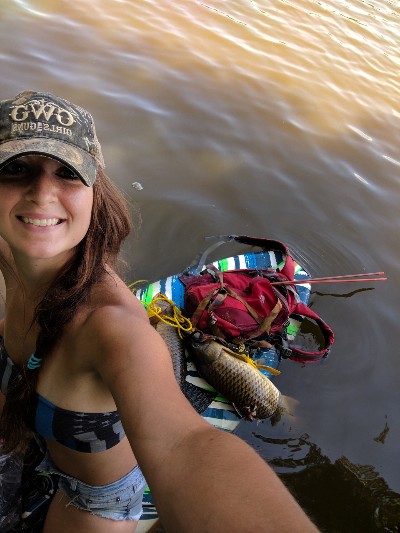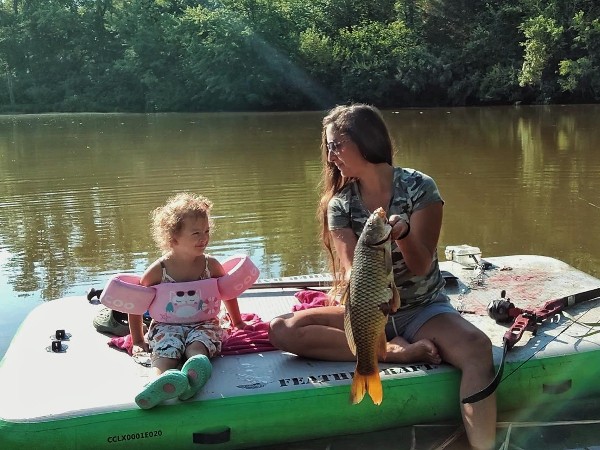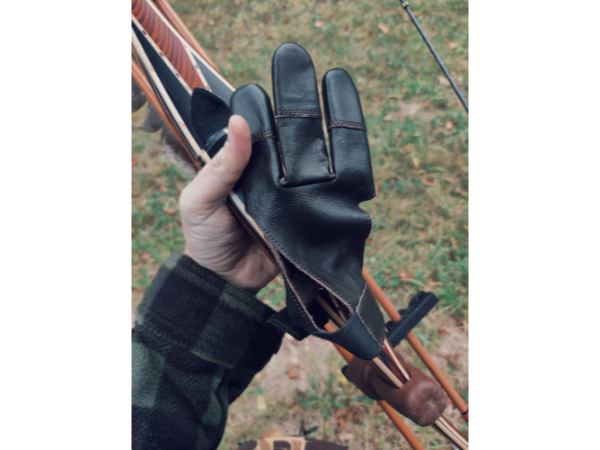When people think of bowfishing, the image most will conjure up in their heads involves a boat and spotlights, trolling along a lake or river in the dead of night. Yet, that wasn’t how I began bowfishing and to this day is not my preferred method of shooting fish. I started out bowfishing on the banks of a river, wading barefoot through the murky shallows while the sun beat down on my back, shooting any carp that stuck its head up to the surface of the muddy water. For years I continued to bowfish this way, taking joy in the simplicity of shooting fish from shore and making the most of the long, hot days of summer.

The author after a successful day bowfishing a local lake.
Yet, as I expanded my areas of bowfishing I soon realized that some of the best spots to shoot fish were simply not possible to get to on foot. I really wasn’t in the market to buy a boat; not only did it seem like a huge undertaking financially, but it would create a bit of extra work to get to my spots as well as worrying about boat troubles and repairs. I decided to try and find some small vessel to get out onto the lakes and shoot fish—not a full-size boat but something a little smaller and easier to afford and transport. My first thought was a canoe, paddle board, or a small flat bottom boat with a trolling motor. A canoe would be the easiest option, however, it would be the least stable. I had previously owned a kayak with stabilizers but it was so heavy that I had a difficult time getting it in and out of the water myself, and eventually I sold it. If I ever own one again I would invest in a trailer to transport it or get a model that is a bit lighter to handle.
Then one day by chance I saw a paddle board on sale at a local big box store: a one-piece foam board. It was a youth board, but I fit the weight limits and decided it couldn’t hurt to give it a try. After I found my “sea legs,” I was completely sold on using a paddle board to bowfish. It was lightweight, easy to transport, and I could paddle anywhere on the lakes and even into the shallowest of waters without worrying about getting stuck. It took some getting used to, shooting from a board. I found that sitting or kneeling helped prevent the fish from seeing me as easily, and I kept a stringer tied to the front of the board to keep the fish I shot. I learned fairly quickly that finding a way to anchor your bow to the board was also essential, as I didn’t want to lose my bow in the bottom of the lake.

A youth model paddle board turned out to be the perfect solution for getting on the water.
I spent several summers floating the lakes on that board, stacking fish up on the front end and getting a good arm workout while paddling. I was completely sold on bowfishing from a board and recommended it to anyone who asked. I will most likely buy another in the future but bump up to adult size so not to worry about weight limits. Eventually, though, my board days came to an end when I became pregnant with my first daughter. Knowing we would quickly exceed the weight limit, I sold the board. I went back to shooting fish from the banks while my daughter was in tow in her backpack carrier, but I really missed being able to get to the middle of the lakes and the hard-to-reach places. After doing some more research, I found an inflatable raft meant for bass fishing that had several air chambers and heavy-duty walls that resisted punctures. On a whim I bought one, and for the past few years it has been one of my best investments. It’s lightweight and easy to transport while filled with air or not; it’s easy to maneuver in the water, stable, with a ton of room for my daughter and I to move around. I’m starting to learn that there is a solution to every problem when it comes to bowfishing problems.
The best way to spend an early summer morning before the sun gets too hot is to launch the raft onto the local lake and slowly float the edges of the water. I’m always looking for telltale signs of carp, the most common fish to shoot here in this area. My daughter, Isabella, has started catching on as to what to look for, and to listen for the gulping sounds of fish mouths sucking air on the surface.
We round a large dead tree with black rotting branches sticking up out of the dark shadows of the water, and up against the base of the tree I see a golden fin sticking above the surface. Several carp are huddled together, a telltale sign of spawning, and I pull my paddle out of the water and let the momentum bring the raft closer to the fish. I ready my recurve and make a snap shot when I’m five yards from the fish. My arrow strikes and the water explodes. The raft is taken on a short ride through the water as I try to reel the fish toward me, and result in pulling the raft more toward he fish—which also works. I pull the fish out of the water onto the raft, and one shake of its tail sends scales and slime all over everything. It’s messy for sure, but man it’s fun.

The author after a successful day bowfishing a local lake.
Now, there are pros and cons to everything and there are definitely cons to bowfishing from a smaller vessel. The wind tends to push you around a bit, so I often skip bowfishing on windy days. The water refraction can also be a little trickier when you’re in a smaller vessel—being closer to the water makes you think you have a sure shot, yet it takes some getting used to. You still have to aim fairly low. Sound is one of the biggest things I have found that makes a difference between shooting fish and not shooting fish. Yes, many avid bowfishers roar through the lakes at full speed with their radios loudly playing, all while having boisterous conversations. However, when on a small raft or boat it’s helpful to just drift into the fish and avoid loud conversation…the noise travels to them a lot more than you would think! You’ll also want to bring a dry bag/dry box for your phone or anything of value and secure it to yourself or the vessel—although this is something I do whether I’m on foot or on a boat.
Equipment Note: The author’s rig consists of a Cajun Fish Stick recurve (45#) and fiberglass bowfishing arrows tipped with Sting-A-Ree bladed heads.







Leave A Comment